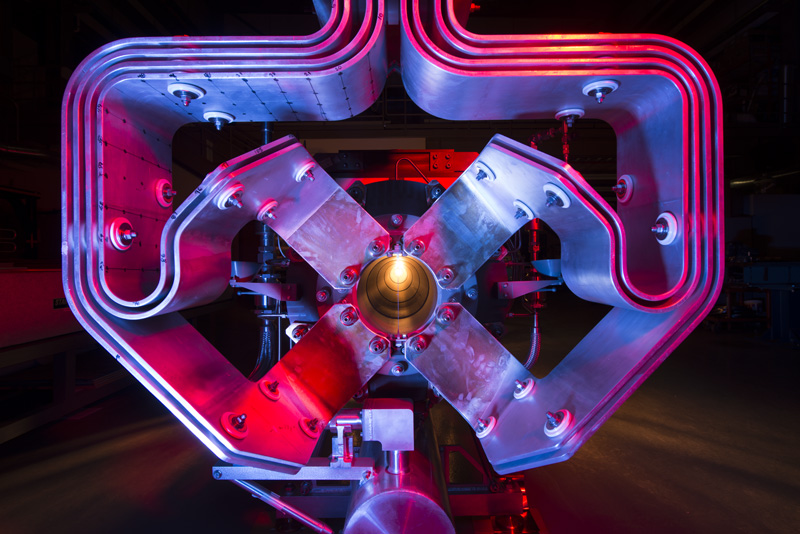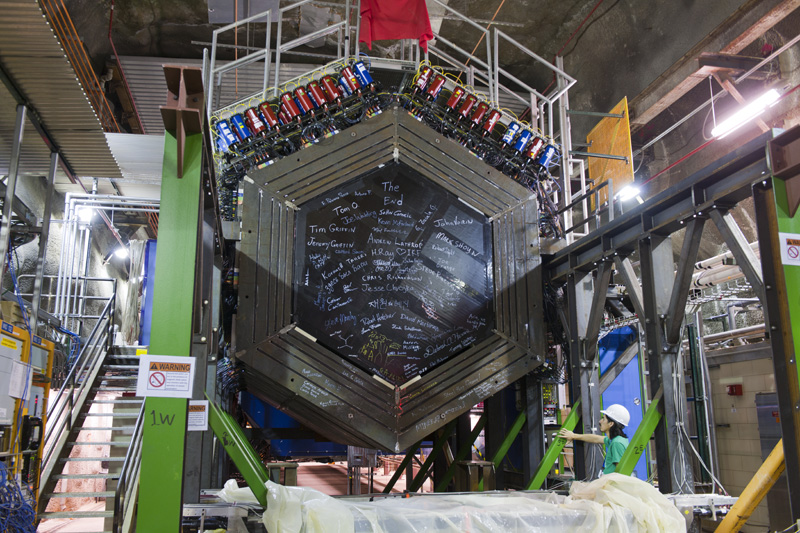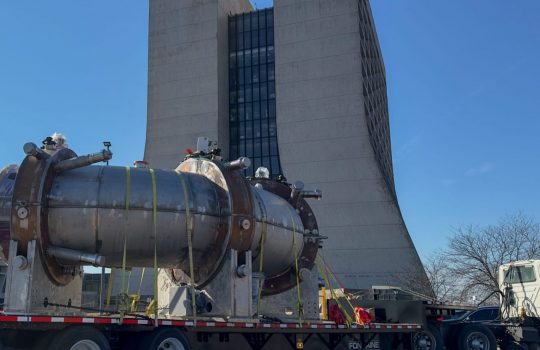Physicists used MINERvA, a Fermilab neutrino experiment, to measure the proton’s size and structure using a neutrino-scattering technique.
For the first time, particle physicists have been able to precisely measure the proton’s size and structure using neutrinos. With data gathered from thousands of neutrino-hydrogen scattering events collected by MINERvA, a particle physics experiment at the U.S. Department of Energy’s Fermi National Accelerator Laboratory, physicists have found a new lens for exploring protons. The results were published today in the scientific journal Nature.
This measurement is also important for analyzing data from experiments that aim to measure the properties of neutrinos with great precision, including the future Deep Underground Neutrino Experiment, hosted by Fermilab.

One of two magnetic focusing horns used in the beamline at Fermilab that produces intense neutrino beams for MINERvA and other neutrino experiments. Photo: Reidar Hahn, Fermilab
“The MINERvA experiment has found a novel way for us to see and understand proton structure, critical both for our understanding of the building blocks of matter and for our ability to interpret results from the flagship DUNE experiment on the horizon,” said Bonnie Fleming, Fermilab deputy director for science and technology.
Protons and neutrons are the particles that make up the nucleus, or core, of an atom. Understanding their size and structure is essential to understand particle interactions. But it is very difficult to measure things at subatomic scales. Protons — about a femtometer, or 10-15 meters, in diameter — are too small to examine with visible light. Instead, scientists use particles accelerated to high energies. Their wavelengths are capable of probing miniscule scales.
Starting in the 1950s, particle physicists used electrons to measure the size and structure of the proton. Electrons are electrically charged, which means they interact with the electromagnetic force distribution in the proton. By shooting a beam of accelerated electrons at a target containing lots of atoms, physicists can observe how the electrons interact with the protons and thus how the electromagnetic force is distributed in a proton. Performing increasingly more precise experiments, physicists now have measured the proton’s electric charge radius to be 0.877 femtometers.
The MINERvA collaboration achieved its groundbreaking result by using particles called neutrinos in lieu of electrons. Specifically, they used antineutrinos, the antimatter partners of neutrinos. Unlike electrons, neutrinos and antineutrinos have no electric charge; they only interact with other particles via the weak nuclear force. This makes them sensitive to the “weak charge” distribution inside a proton.
However, neutrinos and antineutrinos rarely interact with protons — hence the name weak force. To collect enough scattering events to make a statistically meaningful measurement, MINERvA scientists needed to smash a lot of antineutrinos into a lot of protons.
Fortunately, Fermilab is home to the world’s most powerful high-energy neutrino and antineutrino beams. And MINERvA contains a lot of protons. Located 100 meters underground at Fermilab’s campus in Batavia, Illinois, MINERvA was designed to perform high-precision measurements of neutrino interactions on a wide variety of materials, including carbon, lead and plastic.
The MINERvA experiment has found a novel way for us to see and understand proton structure.
– Bonnie Fleming
To measure the proton structure with high precision, scientists ideally would send neutrinos or antineutrinos into a very dense target made only of hydrogen, which contains protons but no neutrons. That is experimentally challenging, if not impossible to achieve. Instead, the MINERvA detector contains hydrogen that is closely bonded to carbon in the form of a plastic called polystyrene. But no one had ever tried to separate hydrogen data from carbon data.
“If we were not optimists, we would say it’s impossible,” said Tejin Cai, a postdoctoral researcher at York University and lead author on the Nature paper. Cai performed this research for his doctorate at the University of Rochester. “The hydrogen and carbon are chemically bonded together, so the detector sees interactions on both at once. But then, I realized that the very nuclear effects that made scattering on carbon complicated also allowed us to select hydrogen and would allow us to subtract off the carbon interactions.”
Cai and Arie Bodek, a professor at the University of Rochester, proposed using MINERvA’s polystyrene target to measure antineutrinos scattering off protons in hydrogen and carbon nuclei to Cai’s Ph.D. advisor, Kevin McFarland. Together, they developed algorithms to subtract the large carbon background by identifying neutrons produced from antineutrinos scattering off carbon atoms.
“When Tejin and Arie first suggested trying this analysis, I thought it would be too difficult, and I wasn’t encouraging. Tejin persevered and proved it could be done,” said McFarland, a professor at the University of Rochester. “One of the best parts of being a teacher is having a student who learns enough to prove you wrong.”
Cai and his collaborators used MINERvA to record more than a million antineutrino interactions over the course of three years. They determined that about 5,000 of these were neutrino-hydrogen scattering events.

MINERvA used a collider detector design and a high-intensity beam to study neutrino reactions with five different nuclei, creating the first self-contained comparison of interactions in different elements. Credit: Fermilab
With these data, they inferred the size of the proton’s weak charge radius to be 0.73 ± 0.17 femtometers. It is the first statistically significant measurement of the proton’s radius using neutrinos. Within its uncertainties, the result aligns with the electric charge radius measured with electron scattering.
The result shows that physicists can use this neutrino-scattering technique to see the proton through a new lens. It is like how looking at the universe in different wavelengths allows astronomers to study the universe in new ways, as seen with the infrared-sensitive James Webb Space Telescope.
The result also provides a better understanding of the proton’s structure. This can be used to predict the behavior of groups of protons in an atom’s nucleus. If physicists start with a better measurement of neutrino-proton interactions, they can make better models of neutrino-nucleus interactions. This will improve the performance of other neutrino experiments, such as NOvA at Fermilab and T2K in Japan.
For Cai, one of the most exciting things about the result is showing that, “Even with a general particle detector, we can do things we didn’t imagine we could do.”
Co-spokesperson for the MINERvA collaboration Deborah Harris, scientist at Fermilab and professor of physics at York University, said, “When we proposed MINERvA, we never thought we’d be able to extract measurements from the hydrogen in the detector. Making this work required great performance from the detector, creative analysis ideas and years of running in the most intense high-energy neutrino beam on the planet.”
This work is supported by the DOE Office of Science, National Science Foundation, Coordination for the Improvement of Higher Education Personnel in Brazil, Brazilian National Council for Scientific and Technological Development, Mexican National Council of Science and Technology, Basal Project in Chile, Chilean National Commission for Scientific and Technological Research, Chilean National Fund for Scientific and Technological Development, Peruvian National Council for Science, Technology and Technological Innovation, Research Management Directorate at the Pontifical Catholic University of Peru, National University of Engineering in Peru, Polish National Science Center and UK Science and Technology Facilities Council.
Fermi National Accelerator Laboratory is supported by the Office of Science of the U.S. Department of Energy. The Office of Science is the single largest supporter of basic research in the physical sciences in the United States and is working to address some of the most pressing challenges of our time. For more information, visit science.energy.gov.



